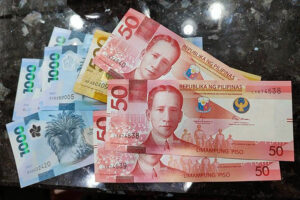By Luisa Maria Jacinta C. Jocson, Reporter
THE PESO could sink to the P60-per-dollar mark this year due to potential protectionist policies from the administration of US President-elect Donald J. Trump, Fitch Solutions’ unit BMI said, which could lead to further intervention by the Bangko Sentral ng Pilipinas (BSP).
“Breaching the P60.00/USD level remains a very real possibility and much depends on how Trump’s policies will shape up,” BMI said in a report dated Jan. 13.
“If the newly elected president opts for very aggressive protectionism policies that take markets by surprise, the dollar could reach another all-time high. And in the event this occurs, BSP intervention in the FX (foreign exchange) market will prove ineffective.”
At end-2024, the peso closed at P57.845 versus the dollar, depreciating by 4.28% from its end-2023 finish of P55.37 against the greenback.
The peso closed at its record low of P59 thrice last year. It has yet to breach this level that was first set in October 2022.
BMI said the US Federal Reserve’s hawkish tilt amid lingering inflation concerns has caused volatility among emerging market currencies.
“Likewise, the peso is no exception and is trading at P58.39/USD on the spot rate. This ran counter to our original projection for the peso to strengthen by end-2024,” it said.
“To be fair, our previous projection was based on a Harris victory that simply did not materialize. With Trump’s return to the White House, and the accompanying policy overhang, this will keep the dollar strong,” BMI added.
Economies around the world are bracing for the potential inflationary pressures arising from the proposed policies of Mr. Trump, who will take office on Jan. 20. Among these are import tariffs, tax cuts and tighter immigration measures.
For now, BMI said there is “not much clarity” on Mr. Trump’s policies.
“But it is still too early to tell if Trump will follow through on his plans. He could still deliver a more watered-down approach to his promises by implementing smaller blanket tariffs as opposed to the 10-20% he originally suggested,” it said.
“Until more details of his policies are revealed, markets will speculate on his every move.”
The dollar hovered near its highest level in more than two years on Tuesday as traders scale back wagers on US rate cuts in 2025 after strong economic data, Reuters reported.
Traders are pricing in 29 basis points of easing this year, less than the 50 basis points the Fed projected in December, when it jolted the market with its measured approach to rate cuts due to inflation worries.
BMI expects the peso to trade between the P55.20 to P59.20 range this year. In the first two weeks of 2025, it has mostly traded at the P58 level, even setting multi-week lows in the past few days after a slew of strong US economic data stoked inflation concerns and caused markets to recalibrate their Fed easing bets.
“For sure, the peso would have traded weaker had the BSP not stepped in to arrest its decline. It is well documented in news outlets that the bank will not hesitate to intervene when the currency comes under undue stress,” BMI said.
“And the recent decline in foreign reserves confirms our view. If anything, this reflects the BSP’s commitment to keep the currency at around current levels.”
Latest data from the BSP showed the country’s gross international reserves (GIR) dropped by 1.5% to $106.84 billion at end-December from $108.49 billion at end-November.
BMI said central bank intervention will help “curb depreciatory pressures” on the currency.
“In the coming months, the BSP will need to intervene more actively as US interest rate changes continue to add volatility to the peso.”
BSP Governor Eli M. Remolona, Jr. earlier said they have been intervening in small amounts to keep markets orderly and curb speculation.
BMI also noted the impact of monetary easing on the currency.
“Even so, any appreciatory pressures will be constrained by the BSP’s loosening cycle. Admittedly, we are expecting the BSP to cut rates by less than the Fed.”
It said it expects the BSP to deliver 75 bps worth of cuts this year and the US central bank to slash rates by 100 bps.
“But with the economy in need of support, policy makers will likely implement the bulk of cuts in the first half even as the Fed does so in the second half. This means interest rate differentials will widen slightly in favor of the US,” it added.
The US central bank began its rate-cutting cycle in September, slashing rates by a cumulative 100 bps last year.
The BSP, which cut ahead of the Fed in August, delivered a total of 75 bps worth of cuts last year. This brought the policy rate to 5.75%.
PESO WEAKNESS TO PERSISTMeanwhile, BMI said the peso will likely remain on a “depreciatory trend” in the next six to 24 months.
For this year, the Development Budget Coordination Committee (DBCC) expects the peso to range from P56 to P58.
“The biggest reason is that the Philippines will continue to run ‘twin deficits’ which will pose challenges for the currency,” it said.
BMI expects the current account deficit to widen to 2.5% of gross domestic product (GDP) this year from 2.3% in 2024.
In the first nine months of 2024, the current account deficit accounted for 3.9% of GDP.
“And we are even more certain that it will not return to pre-pandemic norms at least until the next presidential elections in 2028,” it said.
“The government’s plans to spend 5-6% of GDP annually on infrastructure which will keep capital imports high and the current account deficit wide.”

